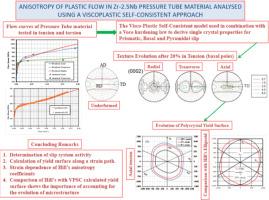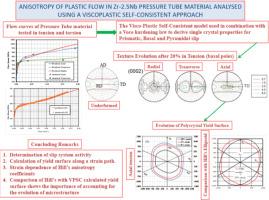利用粘弹性自稳方法分析 Zr-2.5Nb 压力管材料中塑料流动的抗变形性
IF 8.3
1区 材料科学
Q1 MATERIALS SCIENCE, MULTIDISCIPLINARY
引用次数: 0
摘要
在 CANDU1 核反应堆中使用的 Zr-2.5Nb 压力管的轴向和横向样品中观察到塑性各向异性。此外,还通过对相同材料的 "迷你 "压力管进行扭转测试,测量了其在剪切过程中的塑性各向异性。使用粘弹性自洽模型对这些实验的室温结果进行了分析,该模型考虑了材料的晶体学纹理,并允许通过每个滑移系统特有的变形定律来描述单晶加工硬化行为。粘塑自洽模型用于推导:(i) 与棱柱形、基座形和金字塔形位错滑移一致的临界分辨剪切应力值随应变的演变;(ii) 滑移系统活动随应变的演变;(iii) 希尔塑性各向异性系数的值,这些值与观察到的屈服各向异性及其对累积应变的依赖性一致。该模型还可以预测无法通过实验测量的流动应力张量成分及其与压力管材料加工硬化行为的关系。此外,与使用希尔各向异性系数得出的屈服面相比,使用粘弹性自洽模型计算了不同塑性应变量后的屈服面。我们的研究揭示了希尔椭圆体在微结构演变时描述塑性屈服的局限性。本文章由计算机程序翻译,如有差异,请以英文原文为准。


Anisotropy of plastic flow in Zr-2.5Nb pressure tube material analysed using a viscoplastic self-consistent approach
Plastic anisotropy is observed during plastic flow in samples from the axial and transverse directions of Zr-2.5Nb pressure tubes used in CANDU1 nuclear reactors tested in uniaxial tension. Plastic anisotropy was also measured in shear by testing in torsion ‘mini’ pressure tubes from the same material. Room temperature results from these experiments were analysed using a visco-plastic self-consistent model that takes into account the crystallographic texture of the material and allows for the single crystal work hardening behaviour to be described by means of a deformation law specific to each slip system.
The visco-plastic self-consistent model was used to derive: (i) the evolution with strain of the critical resolved shear stress values consistent with prismatic, basal and pyramidal dislocation glide, (ii) the evolution of slip system activity as a function of strain, and (iii) the values of Hill's plastic anisotropy coefficients that are consistent with the observed anisotropy of yielding and their dependence on accumulated strain. The model also allows for the prediction of the components of the flow stress tensor that cannot be measured experimentally and their dependence on the work hardening behaviour of pressure tube material. Moreover, the yield surface after different amounts of plastic strain was calculated using the visco-plastic self-consistent model, compared to the one that results from using the Hill's anisotropy coefficients. Our work exposes the limitations of the Hill ellipsoid for describing plastic yield when microstructural evolution is present.
求助全文
通过发布文献求助,成功后即可免费获取论文全文。
去求助
来源期刊

Acta Materialia
工程技术-材料科学:综合
CiteScore
16.10
自引率
8.50%
发文量
801
审稿时长
53 days
期刊介绍:
Acta Materialia serves as a platform for publishing full-length, original papers and commissioned overviews that contribute to a profound understanding of the correlation between the processing, structure, and properties of inorganic materials. The journal seeks papers with high impact potential or those that significantly propel the field forward. The scope includes the atomic and molecular arrangements, chemical and electronic structures, and microstructure of materials, focusing on their mechanical or functional behavior across all length scales, including nanostructures.
 求助内容:
求助内容: 应助结果提醒方式:
应助结果提醒方式:


